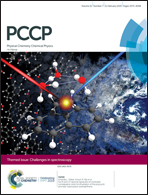Dipolar coupling and molecular vibrations in ionic liquids
Abstract
It is often the case that intense, non-degenerate bands appear asymmetric in transmission IR spectra of ionic liquids, with a high-frequency shoulder adjacent to the dominant band. Moreover, the band shape is temperature dependent with lower temperatures producing greater amounts of asymmetry. The 1-alkyl-3-methylimidazolium trifluoromethanesulfonate family of ionic liquids provides an excellent illustration of this phenomenon, wherein the νs(SO3) mode of the anion is split into two components whose frequencies change with temperature. In this article, a new theoretical model is derived to explain temperature-dependent trends in the infrared spectra of these materials. According to the model, vibrationally-induced dipole moments couple with one another across the charge-organized liquid structure inherent to ionic liquids to produce transverse optical (TO) and longitudinal optical (LO) phonons. The temperature dependence of the resulting TO–LO band splitting originates from two distinct sources. First, the interaction strength between vibrationally-induced dipole moments depends on the distance separating the ions, which in turn, is directly related to the ionic liquid's density. Second, TO–LO splitting requires a significant amount of angular correlation among the ions to facilitate the propagation of optical phonons. Elevated temperatures produce smaller densities and increased amounts of disorder, both of which lead to decreased amounts of TO–LO splitting. Although the model is developed in the context of ionic liquids, the equations are broadly applicable to other materials that possess long-range structure but are not fully crystalline, such as molten salts, plastic crystalline compounds, glasses, and disordered solids.



 Please wait while we load your content...
Please wait while we load your content...